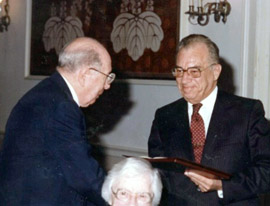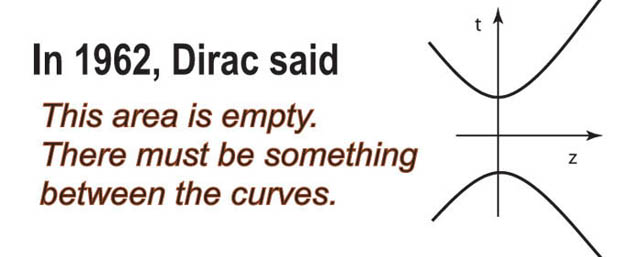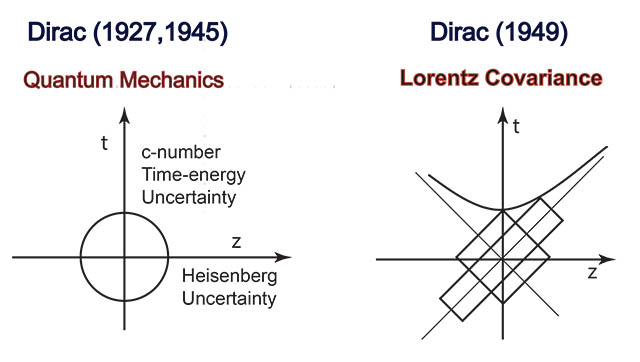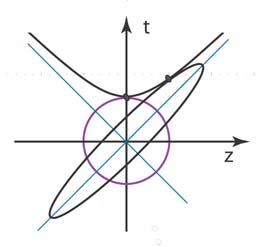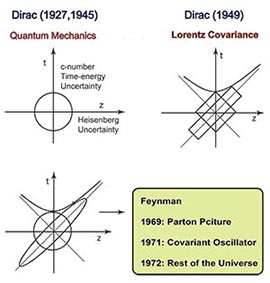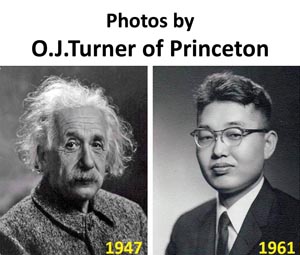Wigner's Sisters
-
Y. S. Kim
Department of Physics, University of Maryland,
College Park, Maryland 20742, U.S.A.
(written in 1995)
Aabstract: Paul A. M. Dirac was a great physicist. Wigner used to call him "my famous brother-in-law." How did they become brothers-in-law? Did these two great physicists have the same view toward physics?
- A. Szanton, "The Recollection of Eugene P. Wigner" (Plenum, New York, 1992).
- Y. S. Kim and M. E. Noz, "Theory and Applications of the Poincaré Group" (Reidel, Dordrecht, 1986).
- M. A. del Omo, Math. Rev. {88a}, 160 (1988).
- Hungary is a Christian country which does not allow more than one wife.
- The Annex restaurant is located on Nassau Street across from the Firestone Library of Princeton University. This restaurant had a different name before 1949.
- M. E. Noz and Y. S. Kim, "Special Relativity and Quantum Theory," Edited Volume consisting of Wigner's papers, Dirac's papers, and others (Kluwer, Dordrecht, 1988).
- P. A. M. Dirac, "Quantum Electrodynamics," Comm. Dublin Inst. Adv. Stud." ser. A, No.1 (1943).
- P. A. M. Dirac, Proc. Roy. Soc. (London) {A183}, 284 (1945).
- P. A. M. Dirac, J. Math. Phys. {4}, 901 (1963).
- P. A. M. Dirac, Rev. Mod. Phys. {21}, 392 (1949).
- E. P. Wigner, Ann. Math. {40}, 149 (1939).
I have been asked by the organizers of the 4th Wigner Symposium (Guadalajara, Mexico 1995) to write about Eugene Wigner's life. Yes, he was a great physicist and was a great human being. I have been fortunate enough to have been associated with him especially in his late years. However, it will require years of full-time research to write his biography if anyone decides to do so. In the meantime, there is a an excellent book about him entitled "Recollections of Eugene P. Wigner as told by Andrew Szanton" [1].
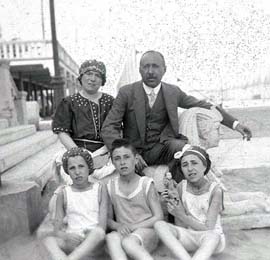
|
| Eugene Wigner with his parents and two sisters. On his right is Manci (Margit) Dirac. |
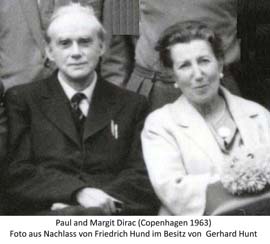
|
E. P. Wigner's noteworthy paper [Ann. Math. {\bf 40}, 149-204 (1939)] was the source of inspiration for the authors when writing this book. There is also a remarkable trace of some of Dirac's papers in the book.
According to this review, I am in a position to say something about Wigner and his brother-in-law whose name was Paul Adrien Maurice Dirac. When I was visiting Wigner frequently during the period 1985--90, he had two sisters living in the United States. They were all born in Hungary in a well-to-do family. His elder sister was in Binghamton (New York), and his younger sister was and still is in Tallahassee (Florida). The elder sister's health was deteriorating, and Wigner was always concerned about her and talking about her. The younger sister's name is Margit Dirac or Mrs. Paul A. M. Dirac. She is known as Manci in the physics community. One day when I was in Wigner's office at Princeton, he made a telephone call to Manci in order to say "Happy Birthday" to her. After a brief talk in Hungarian, Wigner laughed and told me Manci was complaining that his call disrupted her shopping trip. He then told me how she became Mrs. Dirac.
Manci was married to a very wealthy man in Hungary. However, at that time in Hungary or perhaps in other parts of the world, it was not uncommon for a wealthy man to have several wives (though not formally allowed).
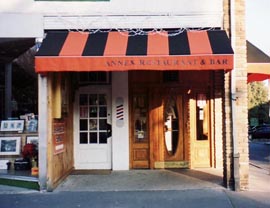
|
| Princeton's Annex Restaurant on Nassau Street (top), two famous brothers-in-law. |
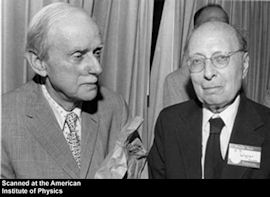
|
I met Mrs. Manci Dirac 1978 in Miami (Florida) while attending one of the Coral Gables conferences. I had a burning question to her husband, and I abruptly joined their "husband-wife" conversation in the lobby of the hotel where the conference participants were staying. After I finished the conversation with Paul Dirac, Manci asked me where I came from originally. I told her I came from Korea in 1954 right after high-school graduation. She then told me that I must have been there during the Korean Conflict (1950--53). After I said Yes to her, she asked me how I felt about the result of the inconclusive war which left the country divided. It was quite clear to me that she was extending to a man from Korea her sympathy toward Hungary which is also prone to invasion and dominance by foreign powers, and I gave my appropriate answer to her. While she was talking, I also watched her husband who was a great physicist. He looked amused but did not show any emotion.
Michaels's family restaurants in Trenton. Assuming that Manci knew about England because she lived there, I asked her a few questions about the British prime ministers, particularly about Anthony Eden who succeeded Winston Churchill but had to resign after the Suez crisis in 1956. Not many people talk about him these days. She explained to me the events during the Suez crisis like a history teacher, and she had her own opinion about what happened and what did not happen at that time. I do not know her exact age, but she must have been about eighty years old at that time. She sounded like a professional lady of my age.
Eugene Wigner also used to make his views known, and it is well known that not everybody agreed with him on the issues having to do with the communist world. Yet, I have to point out that he told me many many times Mikhail Gorbachev is a great man. Wigner always wanted to live peacefully with the people on the other side of the Iron Curtain. He had a distaste for the communist regime in Hungary, but his passion for his native country was so strong that I had to contact the science attache of the Hungarian Embassy in Washington. As a result, the Hungarian Ambassador invited Wigner to his residence during the spring meeting of the American Physical Society (April 1988) held in Baltimore. The Ambassador, presumably a member of the Hungarian Communist Party, was kind enough to send his own limousine to Baltimore's convention center where the APS meeting was held. He later arranged Wigner's membership in the Hungarian Academy of Sciences. The Ambassador's name was Vencel Hazi. He did what he had to do, but I am still grateful to him. Indeed, he was a very good communist.
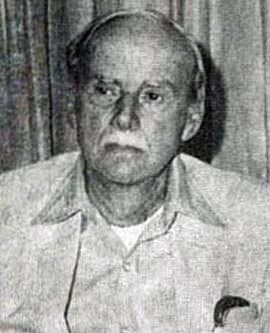
| |
|
On the other hand, we were not fortunate enough to have Manci as a physicist. This is particularly so because there is a gap between Dirac's approach and Wigner's approach to physics even though they had the same ultimate goal in physics. Manci could have filled this gap if she had been born as a physicist. What was then their common goal? Dirac and Wigner both had a distaste for renormalization procedure, and therefore they did not accept the present form of quantum field theory as the ultimate theory. Yet, both of them believed that the uncertainty principle should someday be made consistent with special relativity if not general relativity [6].
During the period 1985--90, Wigner was keenly interested in approaching this problem by constructing representations of the Poincaré group using quantum phase-space distribution functions which are widely known as Wigner functions. Dirac, on the other hand, believed that fundamental laws in physics should appear as beautiful mathematics. His publication list indicates clearly that he was quite fond of building relativistic models using harmonic oscillators [7-9]. I was indeed fortunate to be able to explains to Wigner what Dirac did, and he used to enjoy listening to me.
Dirac wrote a number of papers on the Lorentz group. His best known paper on this subject is entitled "Forms of Relativistic Dynamics" and is in the special issue of the "Reviews of Modern Physics" dedicated to Einstein's 70th birthday in 1949 [10]. In this paper, Dirac writes down the commutation relations, which he calls the Poisson brackets, for the generators of the Poincaré group, and states that "the problem of finding a new dynamical system reduces to the problem of finding a new solutions of these equations." This is exactly what Wigner proposed in his 1939 paper on the "Inhomogneous Lorentz Group " [11]. Dirac's "instant form" and "front form" can be connected to Wigner's O(3)-like and E(2)-like little groups for massive and massless particles respectively [2]. As I said earlier in this report, I had a "burning question" to Dirac in 1978 simply because I wanted to understand Dirac's 1949 paper [10] in terms of Wigner's representation theory. Dirac of course gave me his clear answers in terms of what he said in his own papers, but he was not familiar with the papers written on the same subject by his "famous brother-in-law."
It is somewhat frustrating to note that these two "great brothers-in-law" did not have much communication with each other in physics. On the other hand, I was able to find many homework problems from this gap, and this is why I was able to write my first book. This will explain why Del Olmo made a remark about Dirac's influence on my book with Noz [2,3]. But this story is not restricted to me or to my book. The communication gap between these two great physicists offers a great challenge to many young physicists. Try to establish a bridge between Dirac and Wigner. It may become a very profitable enterprise.
-
based on the preface of the Proceedings of the
4th International Wigner Symposium, edited by N. M. Atakishiyev,
T. H. Seligman, and K. B. Wolf (World Scientific, Singapore, 1996).
Note added in 2015
Dirac and Feynman in Poland
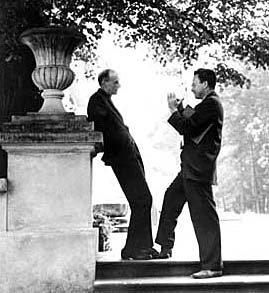
| |
| |

|
- This photo made a so profound impact on the career of one of your
colleagues that he had to make a
pilgrimage to this spot in November of
2013. You are right. I am talking about myself. It is OK if you do not
understand my papers, but you cannot deny the continuity in my publication
list starting from 1961, and I am still writing.
Many of you in the past wrote strong negative referee reports on my papers, and you will have more opportunities to do so in the future. However, you have never been able to stop me from doing physics. The reason is very simple. I believe in these two great physicists.
- Both of them were interested in making quantum mechanics consistent
with relativity, but they took different routes with different styles.
Thus, it is a great challenge to every physicist to complete the job of
combining quantum mechanics with relativity by combining the papers
published by them.
- We can compare these two physicists in the following table.
Name of
PhysicistDirac Feynman Means of
ExpressionMathematical Poems Cartoons and Diagrams Primary
InterestBound States,
Standing WavesScattering States,
Running WavesPersonality Seldom talks to anyone. Willing to join the crowd anywhere in the world. Favorite tools of research 4-by-4 matrices,
Harmonic OscillatorsPath integrals,
Harmonic OscillatorsWhat they did
not see.Their physics can be formulated within the framework of Wigner's representation theory. The question is how to combine these the approaches made by these two physicicsts into one physics. Click here.



- Let us now see some photos I took when I was at the Jablonna Palace
in November.
- This is a photo of myself standing at the place where Dirac and Feynman attempted to talk each other.
- I am trying to imitate Dirac and Feynman at the same spot, but not
too well. Click here for the photo.
- The Jablonna Palace has its history. The Palace is now owned by the Polish academy of Science.
- The surrounding area is a quiet park, and you have to walk some distance to reach the main building from the bus stop.
- The front yard of the Palace. When I was there, movie crews were there taking photos.
- The backyard was a park.
Here is
another photo of the backyard.
- The floor of the main ball room. This room is now used for conference receptions and coffee breaks.
- The ceiling was very high, and this is the photo of the ceiling.
- One of the small conference rooms.
- The big conference room. This
is big enough for 30 or 40 participants, but not for more than 100 people.
- One of the decorative items. There are many more expensive items.
- Dining room in the basement.
- Entrance corridor with items to make you feel you are at special place.
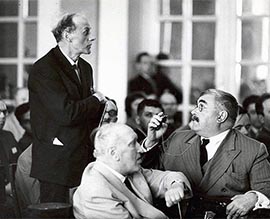
Dirac, Infeld, and Fock (photo by Marek Holzman), contribution from Andrzej Trautman. - For the Jablonna Conference of 1962,
Leopold Infeld
was the principal organizer, Infeld is
a very important person to me. While reading his papers,
I got a pivotal idea
for formulating my own research program in physics.
-
Iwo Bialnick-Birula was one of the younger organizers
for this historic conference.
- He had a photo with Feynman there, taken also by Marek Holzman.
- He had a photo with me in 2006 at a Vaxjo conference in Sweden.
-
Andrzej Trautman presented his paper at this conference.
- He sent us this photo, containing images of Dirac, Infeld and Fock.
- Please send us more Jablonna photos!
-
Iwo Bialnick-Birula was one of the younger organizers
for this historic conference.
I met Paul A. M. Dirac in 1962.
|

